

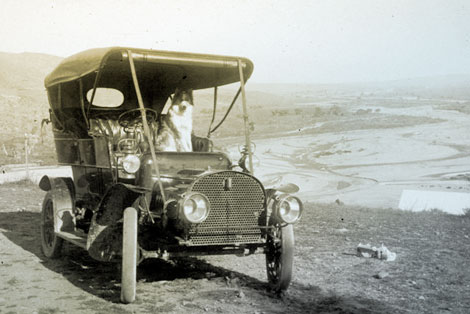 Lubken took this photo of his car and, presumably, his dog in March 1907 somewhere near the town of Roosevelt. The Salt River floodplain is in the background. (Reclamation photograph)
Lubken took this photo of his car and, presumably, his dog in March 1907 somewhere near the town of Roosevelt. The Salt River floodplain is in the background. (Reclamation photograph)-at-Arrowrock-Dam.jpg) Photographs of Walter Lubken are rare. In this photograph, Lubken is on the left holding a cigar. The photograph was taken at Arrowrock Dam, Idaho, in 1912. (Reclamation photograph)
Photographs of Walter Lubken are rare. In this photograph, Lubken is on the left holding a cigar. The photograph was taken at Arrowrock Dam, Idaho, in 1912. (Reclamation photograph)Only 22 years old when he was hired as a photographer by the newly formed U.S. Reclamation Service, Walter J. Lubken spent the next 14 years traveling through 17 western states taking pictures of Reclamation Service projects. He photographed at least 23 of the 25 U.S. Reclamation Service projects until 1917, when he and the Reclamation Service parted ways. He was a master craftsman, as his images of the construction of Roosevelt Dam reveal. Fortunately, besides construction photographs, he also photographed the places and people where he worked. His images open a window to life and people of the Salt River Valley and other western areas where he worked in the early twentieth century. Likewise, his photographs of the construction of Roosevelt Dam underscore the remoteness of the dam site and the many challenges faced by the army of architects, engineers, construction workers, and the people who supported them.
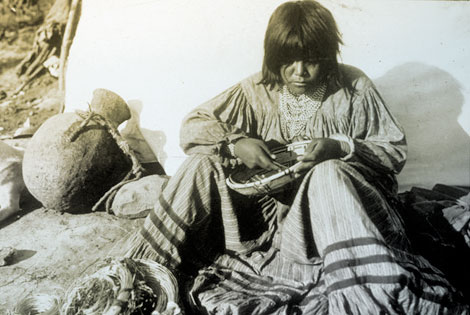 Lubken took a number of photographs of Western Apaches during his time at Roosevelt. Here is an Apache basketmaker, probably at an Apache camp located near the dam construction site. Apache workmen and their families lived in camps segregated from the other workers. (Reclamation photograph)
Lubken took a number of photographs of Western Apaches during his time at Roosevelt. Here is an Apache basketmaker, probably at an Apache camp located near the dam construction site. Apache workmen and their families lived in camps segregated from the other workers. (Reclamation photograph)While photographing the building of Roosevelt Dam, Lubken found time to travel to Yuma where he photographed the Reclamation Service's Yuma Project and the construction of Laguna Dam and a siphon underneath the Colorado River. Here his camera lens revealed life on the Colorado River.
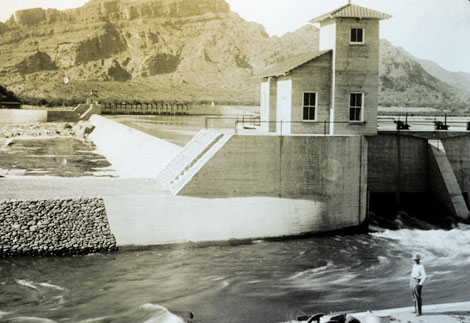 Granite Reef Diversion Dam is located east of Phoenix and diverts water from the Salt River into the Arizona and South canals on the north and south sides of the river, respectively. This 1910 photograph shows the water being diverted into the South Canal. (Reclamation photograph)
Granite Reef Diversion Dam is located east of Phoenix and diverts water from the Salt River into the Arizona and South canals on the north and south sides of the river, respectively. This 1910 photograph shows the water being diverted into the South Canal. (Reclamation photograph)While working for the Reclamation Service, Lubken had a side business selling postcards of Roosevelt Dam and other Reclamation Services projects. From 1907 to 1908 he operated the Lubken Company photography studio in Mesa.
In 1929, when Reclamation was beginning construction of what was to be called Hoover Dam, Lubken was working as a clothing salesman in Boise, Idaho. He tried unsuccessfully to hire on as the agency's photographer, but was hired by Six Companies that was awarded the contract to build the massive dam.
Lubken pursued photography off and on until 1948 when he apparently focused on selling men's clothing. He married Alice C. Hoagland of Boise in 1911; they had no children. Walter J. Lubken died in Boise, Idaho in 1960.
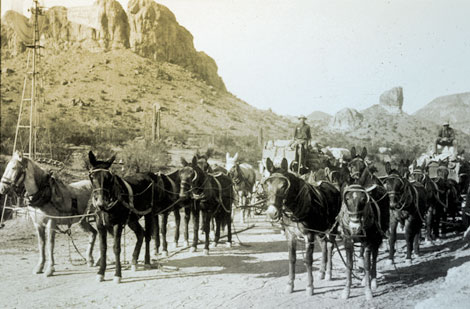 Lubken traveled repeatedly on the Mesa-Roosevelt road between the Salt River Valley and the dam site. At Government Wells where water was available, he captured supply wagons headed to the dam site in December 1907. (Reclamation photograph)
Lubken traveled repeatedly on the Mesa-Roosevelt road between the Salt River Valley and the dam site. At Government Wells where water was available, he captured supply wagons headed to the dam site in December 1907. (Reclamation photograph)
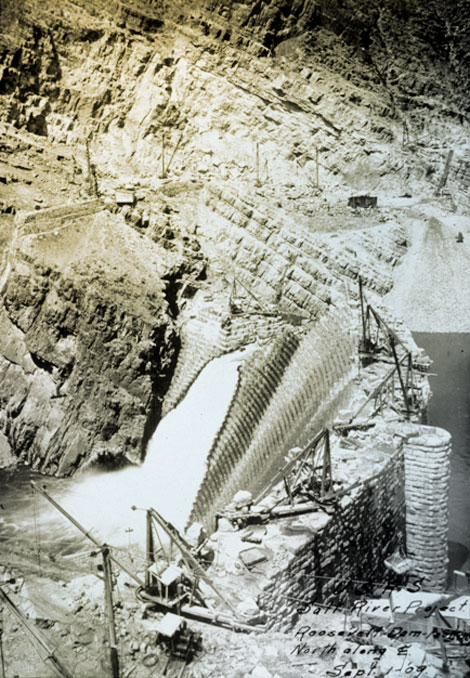 Lubken primarily documented the construction of Roosevelt Dam while in Arizona. This 1909 photograph shows the massive wall of the dam still under construction. (Reclamation photograph)
Lubken primarily documented the construction of Roosevelt Dam while in Arizona. This 1909 photograph shows the massive wall of the dam still under construction. (Reclamation photograph)
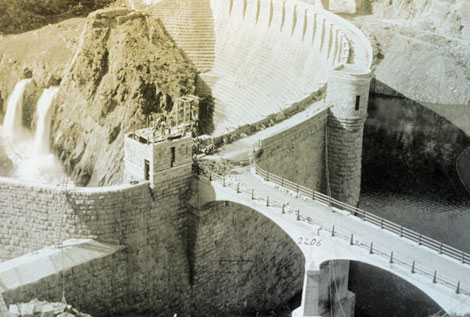 Roosevelt Dam is essentially completed in this photograph, probably taken in late 1910 or early 1911. (Reclamation photograph)
Roosevelt Dam is essentially completed in this photograph, probably taken in late 1910 or early 1911. (Reclamation photograph)
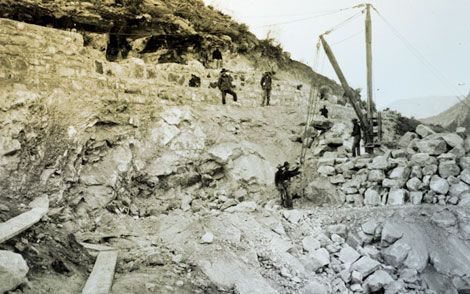 Cement was made at the dam site to save money by avoiding the cost of hauling it from Phoenix. In this 1904 photograph, Lubken captures construction workers building the cement plant. (Reclamation photograph)
Cement was made at the dam site to save money by avoiding the cost of hauling it from Phoenix. In this 1904 photograph, Lubken captures construction workers building the cement plant. (Reclamation photograph)
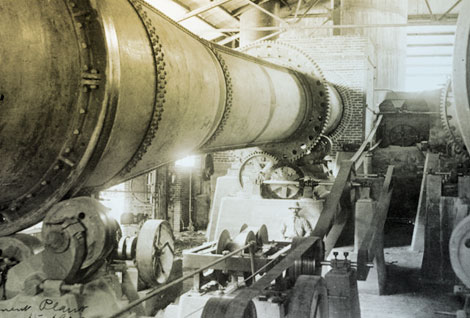 In 1905 Lubken photographed the interior of the newly finished cement plant. Lubken photographed many aspects of the different kinds of facilities that were built on or near the dam site such as the cement plant and a lumber mill in the mountains north of the dam. (Reclamation photograph)
In 1905 Lubken photographed the interior of the newly finished cement plant. Lubken photographed many aspects of the different kinds of facilities that were built on or near the dam site such as the cement plant and a lumber mill in the mountains north of the dam. (Reclamation photograph)
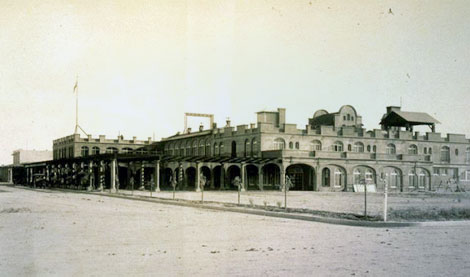 This 1914 photograph of the San Marcos Hotel in Chandler is one of numerous images by Lubken of the buildings, agriculture, canals, and places in the Salt River Valley. For a period of time, Lubken had a small shop in Mesa were he sold postcards of his images. (Reclamation photograph)
This 1914 photograph of the San Marcos Hotel in Chandler is one of numerous images by Lubken of the buildings, agriculture, canals, and places in the Salt River Valley. For a period of time, Lubken had a small shop in Mesa were he sold postcards of his images. (Reclamation photograph)
Portions of this material are from "Walter Lubken, U.S. Reclamation Service Photographer at Roosevelt Dam, A Photo Essay," by David Tackenber. In The Journal of Arizona History, Volume 50, Number 4, Winter 2009. Tucson: Arizona Historical Society.
